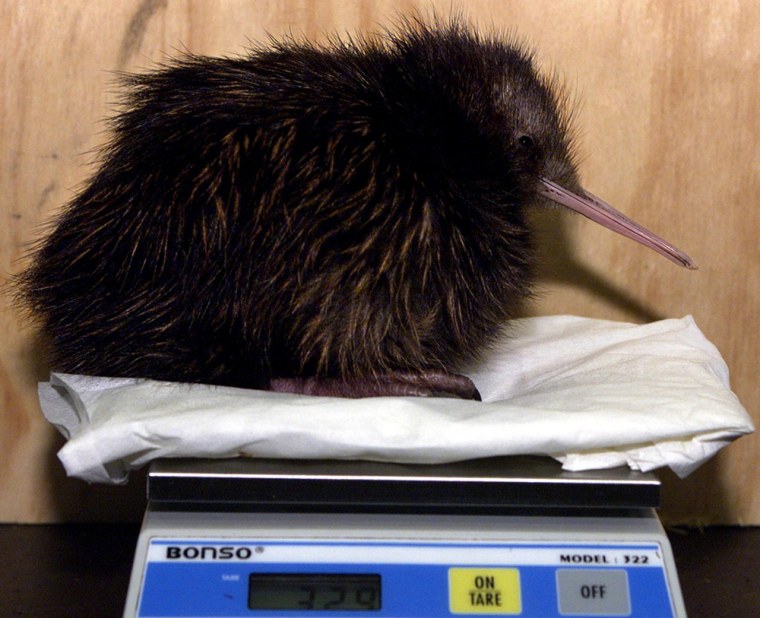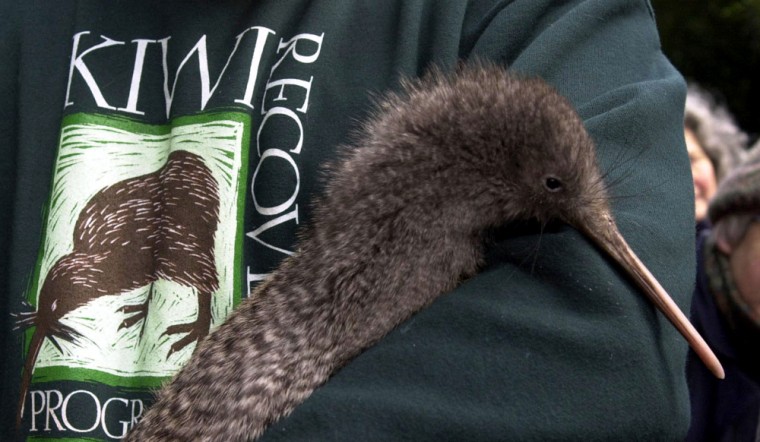As national symbols go, the kiwi makes up in curiosity value for what it lacks in good looks.
The squat, flightless bird appears a bit like a cross between a hamster and an anteater, with furlike plumage, a long, quill-like beak and a grumpy demeanor.
But don't let its looks and ungainliness mislead you. This bird is to New Zealanders what the bald eagle is to Americans.
It's on the coins and many product logos. It's in the indigenous Maori creation myth and lends its name to the fruit, a New Zealand export. It's even a synonym for the currency, as well as for a New Zealander, as in "I'm a kiwi, mate, and proud of it."
The only kiwis in short supply are the creatures themselves. They're an endangered species, now being nursed back to healthy numbers by an innovative conservation effort not far from the bustle of Wellington, the capital.
"When we talk about the kiwi — that's our identity," said Raewyn Empson, conservation manager at the Karori Wildlife Sanctuary. "When all of a sudden you're talking about kiwi becoming extinct in our lifetime, it's a bit scary really."
The kiwi and other species are victims of their own innocence and the twists and turns of evolution and human settlement on these South Pacific islands.
Rugged and wind-swept, New Zealand is so remote that many of its animals had few enemies and never developed strong defense mechanisms.
Rats, cats, dogs are threats
Then, 750 years ago, man began arriving — Polynesians first, with rats in their canoes. Much later, Europeans came, bringing cats, dogs, stoats, ferrets, possums, rabbits and weasels.
The islands were a predator's paradise, and the newcomers ran riot, eating the local wildlife or stealing its lunch.
New Zealand today has one of the world's worst biodiversity depletion rates. More than 30 percent — at least 51 species — of native birds are believed to have died out, along with frogs, lizards, fish and plants, government studies say.
Among them were the giant flightless moa, which the Polynesians hunted to extinction for food. Haste's eagle, dependent on moa for food, died out in about 1400. The eagle, which could weigh more than 30 pounds, was the world's largest.
The kiwi virtually disappeared from New Zealand's mainland, and could only be seen on smaller, less inhabited islands.
But nature-loving New Zealand prides itself on being greener than others, and communities and individuals have rushed to the rescue.
More than two dozen privately run sanctuaries have sprouted in recent years. Thousands of volunteers have stepped up to trap, kill or chase away nonnative predators.
"It has been a major change in the way conservation is done in New Zealand," says Bruce Burns, a biologist who helps run a loose network called Sanctuaries in New Zealand. "Communities are taking the matter into their own hands."
Small isles as sanctuaries
The government has moved at-risk animals to the small islands, where predators can be more easily poisoned.

Karori is trying to do the opposite: bring survivors back to the mainland. The nonprofit trust, funded by individuals, businesses, colleges and local governments, is trying to restore a square mile of river valley to its pre-human state.
Before man arrived, New Zealand's lush forests were populated by "some pretty weird and unusual and primitive animals," says Don Newman, the government Conservation Department's manager of threatened-species science.
They included huge bugs, dinosaur-era reptiles and birds that had forgotten how to fly because they didn't need to — kiwis came down from the trees to forage for food and never went back. Armed only with a nasty kick, they were too slow to escape sharp-toothed predators.
While farmers cleared forest, depriving native species of habitat, the newly arrived mammals raided nests and burrows for eggs and munched their way through countless unique beasts, pushing them toward extinction — the kakapo, the world's only flightless parrot; the tuatara, an ancient foot-long reptile, and a cricket whose Maori name, wetapunga, connotes a god of ugly things.
But at the Karori sanctuary, Empson is undaunted by the damage that needs undoing.
"We've got a 500-year vision here," she says. "We're optimists."
Surrounded by a 7-foot-tall fence that can't be climbed or burrowed under, Karori is viewed as a model among the private sanctuaries, both for its tourism and scientific research potential.
In 2000, little spotted kiwi — the smallest and rarest of the six kiwi species — were released into Karori, returning the bird to the wild on the mainland for the first time in a century.
Within a year a chick was born and named Frodo after the hero-hobbit of the "Lord of the Rings" movies, which were filmed in New Zealand. The park expects to count about 40 of the birds by next year.
In March, rare Maud Island frogs, released at Karori, were found breeding, and in October, tuatara were seen nesting, the first time the reptile is known to have done so on the mainland in 200 years.
Long-departed parrots are back and are spreading out in the Wellington area, while at a feeding station deep in the park, a rare brown teal wanders somewhat gormlessly around the feet of visitors who are taking a nighttime tour.
"This is exactly the sort of behavior that is typical of New Zealand birds, and it's what gets them into trouble. They are practically tame," says guide Claire Pascoe. "It's a terrible evolutionary strategy when you introduce predators, but it is great for bird watching."
Then Pascoe hushes her group and cocks an ear to a telltale trill.
Out of the underbrush, a bantam-sized bird hops onto the trail and up a set of steps, its human entourage in hot, if muffled, pursuit. It's a female little spotted kiwi, picking its way through the thicket.
So, is humankind finally giving the kiwi an edge over its enemies? One indication could be the pocket-sized kiwi trinkets in Karori's gift shop. They're made with possum fur.
